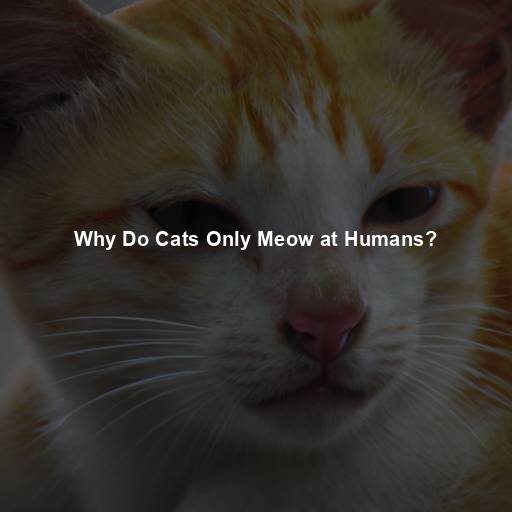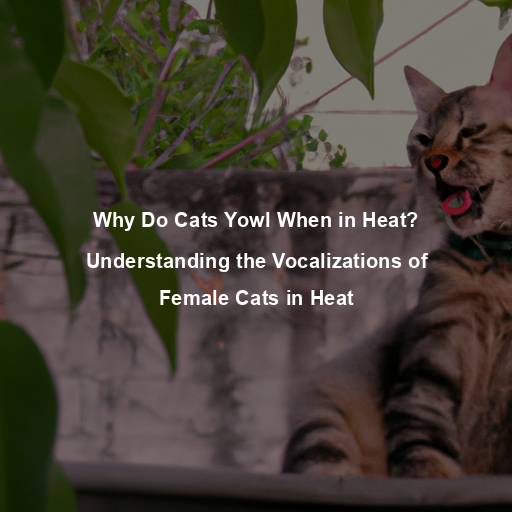Are Cats in Pain When They are in Heat?
Last Updated on November 16, 2023 by Evan
Contents
- 1 Understanding the Heat Cycle in Cats
- 2 The Heat Cycle and Potential Discomfort
- 3 The Importance of Spaying
- 4 Supporting Your Cat During Heat
- 5 The Decision to Breed or Spay
- 6 FAQs – When Cats Are in Heat, Are They in Pain?
- 6.1 Are cats in pain when they are in heat?
- 6.2 What are the common signs that indicate a cat is in heat?
- 6.3 How long does a cat’s heat cycle last?
- 6.4 How often do female cats go into heat?
- 6.5 Can spaying a cat prevent them from going into heat?
- 6.6 Is there anything I can do to help relieve my cat’s discomfort during heat?
- 6.7 Are male cats affected by a female cat’s heat cycle?
Understanding the Heat Cycle in Cats
Cats are truly captivating creatures that possess an intriguing reproductive cycle, often described as being “in heat,” or estrus. This phase, occurring intermittently throughout a female cat’s lifetime, brings about a range of physical and behavioral transformations that signify their receptiveness to mating. Yet, an enigmatic question lingers and piques the curiosity of numerous pet owners: do cats experience discomfort while in heat? In order to unravel this puzzle, let us embark on a journey of exploration and enlightenment.
The Heat Cycle: A Natural Process
The heat cycle in cats is a normal physiological process that occurs as a result of hormonal changes within their bodies. It is important to note that the heat cycle is not exclusive to domesticated cats but is observed across the feline species. While the specific behaviors and signs may vary from cat to cat, the core purpose remains the same – to attract a mate for reproduction.
Physical and Behavioral Changes
When a female feline embarks on her heat cycle, she undergoes a whirlwind of physiological and behavioral transformations. These enigmatic changes arise from a captivating dance of fluctuating hormones, orchestrating a symphony vital for the continuation of her lineage. Amidst this mystifying phase, a discerning cat lover may discern telltale signs of a cat in heat:
-
Vocalization: One of the most noticeable changes is the increased vocalization. Female cats in heat often become more vocal, emitting distinct calls known as “calling” or “yowling”. These vocalizations serve as a means to attract potential mates.
-
Increased Affection: Cats in heat may exhibit heightened affection towards their owners or even inanimate objects. They may rub against furniture, roll on the floor, or display increased attention-seeking behaviors.
Restlessness can sometimes be a perplexing behavior exhibited by cats who are experiencing the throes of their heat cycle. During this time, felines often demonstrate bursts of activity, restlessly pacing around their surroundings, and showing signs of agitation. It can be confusing to witness these restless episodes as the cat’s inner desire for mating becomes more apparent.
Witnessing the mesmerizing allure of feline courtship is always an enthralling experience. During this enchanting phase, keen observers may notice a captivating display known as the elevated tail position. Female cats, driven by the mystique of their heat, gracefully elevate their tails to the side, revealing their oh-so alluring nether regions. This tantalizing gesture acts as an irresistible entreaty to potential suitors, inviting them to partake in the dance of romantic feline fervor.
- Spraying: Some female cats may engage in spraying behaviors during heat. This is their way of marking territory and attracting males.
The Absence of Pain
Unveiling the enigmatic truth behind feline biology, it turns out that cats in heat are not subjected to physical agony as commonly assumed. Although the telltale behavioral transformations might pose a perplexing challenge for both the vivacious feline and their devoted human companion, it’s essential to acknowledge that the actual distress experienced by the cat is remarkably limited. Wrapped up in the perplexing allure of procreation, the feline’s intricate physiology is meticulously tailored towards the singular objective of finding a suitable partner.
Coping with Behavioral Changes
As a responsible pet owner, it is essential to understand how to support and manage a cat during her heat cycle. Here are some tips to help you cope with the behavioral changes:
- Provide Distractions: Engage your cat in interactive play sessions or provide toys to redirect her attention and energy.
Transform Your Home into a Feline Haven: Craft a sanctuary of tranquility for your beloved cat. Shield them from the jarring cacophony of clattering chaos and unexpected disturbances. Let their delicate senses revel in a serene oasis where serenity reigns supreme. Create an ambiance so soothing, it will transport your feline companion to a world of unruffled bliss.
- Explore the Possibilities: When it comes to feline companionship, it’s important to delve into the realm of spaying. This intriguing option not only puts a pause on unexpected kitten arrivals but also curbs the perplexing heat cycle and its puzzling behavioral tendencies. So, why not embrace the uncertain yet rewarding path of spaying for a harmonious feline partnership?
When it comes to navigating through the labyrinth of perplexing feline behavior and pondering the merits of spaying, seeking the sage advice of a seasoned veterinarian is an absolute must. These knowledgeable professionals possess an intricate understanding of your cat’s unique quirks and can dispense tailored guidance that will lead to a harmonious human-feline coexistence. Don’t let perplexity cloud your judgment; consult a trusted veterinarian and unlock the secrets to your feline companion’s enigmatic world.
The Wonder of Feline Reproduction
Understanding the intricacies of a cat’s heat cycle allows us to appreciate the wonders of feline reproduction. While the behavioral changes during this phase might seem challenging, it is crucial to remember that they are a natural part of a cat’s reproductive instincts. By providing a supportive environment and seeking professional advice when necessary, we can ensure the well-being and happiness of our feline companions.
As feline enthusiasts, it’s essential for us to delve into the intriguing realm of our beloved companions’ heat cycles. Contrary to popular misconceptions, the enigmatic behaviors exhibited during this period are not a testament to their pain, but rather a consequence of intricate hormonal fluctuations. By appreciating and accommodating these innate instincts, we can embark on a journey to navigate this fascinating phase with empathy and astute care.
Length and Frequency of the Heat Cycle
A cat’s heat cycle is a fascinating and enigmatic phenomenon, brimming with intricacies and uncertainties. These enigmatic creatures, influenced by a myriad of intricate factors such as breed, age, and health, embark on their journey into womanhood. Generally, a feline’s maiden heat cycle, often referred to as puberty, graces them between the tender ages of six months to one year. Thereafter, the perplexing and erratic dance of hormones takes them on a wild ride, with bouts of heat recurring every two to three weeks, although this enigmatic rhythm can, of course, bewilderingly deviate.
Understanding the Signs of Heat
When a feline is in heat, her behavior may become quite perplexing. In addition to the previously mentioned shifts in conduct, there are a handful of other indicators to watch out for. These signs can vary from cat to cat, adding an extra layer of burstiness to the fascinating world of feline heat cycles.
Increased Urination
During heat, female cats may urinate more frequently or mark their territory with urine. This behavior is driven by the hormonal changes and serves as a way to attract potential mates.
Swollen Genital Area
When a feline companion finds herself in the midst of fervent feline passions, it is not uncommon for her delicate private region to experience a peculiar and notable expansion. This curious phenomenon, caused by the enigmatic dance of hormones within her feline physique, serves as a telltale indication of her entrance into the alluring realm of estrus.
Seeking Out Male Cats
When female cats are in the heat, their natural instincts may lead them on a quest for affection from male cats, often causing them to become discontented with their current situation. They may become more adventurous, attempting daring escapes from the confines of their home, or exhibit a persistent restlessness. It is of utmost importance during this period to create a secure environment, safeguarding against any potential unintended pregnancies and ensuring the well-being of your feline companion.
The Heat Cycle and Potential Discomfort
The physical and behavioral changes that occur in cats during their heat cycle are a natural process driven by hormonal fluctuations, and they do not typically cause physical pain. However, a female cat may experience some discomfort and disruption to her normal routine due to hormonal changes. It is important for pet owners to provide support, create a safe environment, and consider spaying as a way to manage a cat’s heat cycle and prevent unwanted pregnancies. Seeking professional advice from a veterinarian is recommended for guidance on managing a cat’s heat cycle and making informed decisions about spaying.
The Absence of Physical Pain
When it comes to the heat cycle, it’s intriguing how a female cat’s behavior can be dramatically transformed. However, it’s worth noting that these changes, despite their perplexing nature, don’t usually inflict physical distress upon the feline furry friend. The discomfort that lingers during this period is primarily fueled by her relentless instincts and undeniable urge to reproduce, rather than any tangible physical malady.
Hormonal Discomfort
It is worth mentioning that the hormonal fluctuations during heat can lead to certain discomforts for a female cat. These discomforts are not necessarily painful but can be disruptive to her normal routine. For instance, the restlessness and increased vocalization can affect her sleep patterns and overall well-being. However, it is crucial to differentiate between discomfort and actual pain.
Addressing Discomfort
As pet owners, our role is to provide support and comfort to our cats during their heat cycle. Here are some additional tips to help address any discomfort your cat may experience:
Provide a Safe Space
As responsible pet owners, it’s crucial to create a serene sanctuary for our feline friends when they go through their heat cycle. By providing a designated area that offers tranquility and comfort, we can minimize the likelihood of our dear cats experiencing unnecessary stress or anxiety. Giving them a peaceful retreat during this perplexing time ensures their well-being and preserves our precious bond with them.
Use Comforting Techniques
Gentle stroking or providing a warm and cozy spot for your cat can help soothe her during this time. Creating a familiar and calming environment can make a significant difference in easing any discomfort she may experience.
Consider Natural Remedies
As furparents, we all seek the best for our four-legged companions, especially when it comes to their well-being during those oh-so-complicated heat cycles. Interestingly enough, some of our fellow pet owners have discovered intriguing natural remedies, like herbal supplements or pheromone diffusers, claiming they work like a charm to ease the behavioral shifts and uneasiness our feline friends experience. Don’t fret, though—it’s always wise to consult with your trusty veterinarian to ensure these unconventional options are the right fit for your beloved cat.
The Importance of Spaying
Benefits of Spaying
Spaying, or ovariohysterectomy, is a common surgical procedure performed on female cats to remove their reproductive organs. This procedure offers several benefits, both for the cat and the owner:
Prevention of Unwanted Pregnancies
Spaying your female cat eliminates the risk of unwanted pregnancies. This is especially important if you do not plan on breeding her or if you are unable to provide appropriate care for a litter of kittens.
Reduction of Behavioral Changes
When it comes to our feline friends, there’s often a whirlwind of hormonal changes that can leave us scratching our heads. However, there’s a solution that may leave you feline fine. Spaying your cat can bring a welcome reduction in those unpredictable heat-induced behaviors, offering a more serene and harmonious household for both of you. With the elimination of hormonal roller coasters, you can bid farewell to the disruptions and embrace a calmer, more balanced kitty companion.
Health Benefits
When it comes to the well-being of your beloved feline friend, making informed decisions is paramount. Opting for spaying not only aids in preventing unwanted litters, but it can also bestow various health advantages upon your furry companion. By curbing the potential threat of reproductive ailments like uterine infections and specific cancer types, spaying serves as a prudent step towards ensuring your cat’s overall vitality and longevity.
Timing of Spaying
The ideal time to spay a female cat may vary depending on various factors, including her overall health and the recommendations of your veterinarian. In general, it is often recommended to have cats spayed before their first heat cycle, as this can help prevent certain health issues and unwanted behaviors from developing.
Consulting with a Veterinarian
If you are considering spaying your cat or have any concerns about her heat cycle, it is essential to consult with a veterinarian. They can provide personalized advice based on your cat’s specific needs and help you make an informed decision regarding her reproductive health.
Understanding the Emotional Changes
While the physical and behavioral changes during a cat’s heat cycle are well-documented, it is also important to acknowledge the emotional toll it may have on both the cat and the owner. Cats in heat may experience heightened emotions and display behaviors that reflect their intense reproductive drive. As pet owners, it is essential to recognize and empathize with these emotions to ensure our cats’ well-being.
Increased Anxiety and Restlessness
During heat, female cats may exhibit signs of increased anxiety and restlessness. This can manifest as pacing, excessive grooming, or an inability to settle down. It is important to provide a calm and secure environment for your cat during this time, offering reassurance and comfort.
Frustration and Agitation
When cats are in heat, their untamed reproductive urges can often lead to an overwhelming sense of frustration and agitation. In their relentless quest for a mate, they may resort to scratching furniture, emitting loud vocalizations, or even attempting great escapes from the confines of their homes. The key lies in redirecting their fiery energy towards more constructive avenues such as engaging them in playful activities or providing them with interactive toys that cater to their innate instincts.
The Role of Hormones
The emotional changes observed during a cat’s heat cycle are primarily driven by hormonal fluctuations. The surge of hormones, such as estrogen and progesterone, can impact a cat’s mood and behavior. It is important to remember that these emotional changes are a normal part of the reproductive process and not a reflection of the cat’s overall temperament.
Supporting Your Cat During Heat
Patience and Understanding
As your feline companion enters her heat cycle, it’s crucial to embrace a patient and empathetic approach. Remember that her peculiar actions are a direct outcome of her primal reproductive instincts, devoid of any connection to personal annoyance or defiance. By exuding a serene and kind disposition, you can effectively reduce any supplementary stress or unease your cat might be undergoing.
Providing Enrichment
Creating an immersive world for your feline friend through interactive play sessions and enriching her surroundings can work wonders in soothing the whirlwind of emotions and physical transformations she’s going through. Introduce mind-boggling puzzle toys, enticing scratching posts, and captivating interactive feeders to keep her mind sharp and divert her attention to a world of endless possibilities. Embrace the enigma of her nature and embark on a stimulating journey of discovery and fulfillment for your beloved companion.
Creating a Safe Indoor Environment
To prevent unwanted pregnancies and ensure the safety of your cat, it is crucial to keep her indoors during her heat cycle. This will minimize the risk of her escaping and encountering potential mates. Ensure that windows and doors are secure and consider providing her with a designated area where she feels safe and comfortable.
Seeking Professional Advice
If you find that your cat’s heat cycles are particularly challenging or disruptive, it is advisable to seek professional advice from a veterinarian or an animal behaviorist. They can provide guidance specific to your cat’s needs and offer strategies to manage the emotional aspects of the heat cycle.
The Decision to Breed or Spay
Responsible Breeding
Bringing adorable feline bundles into the world is a decision that warrants thoughtful steps and prudence. Delving into the realm of responsible breeding entails safeguarding the physical and emotional welfare of the mom and dad cats, while diligently seeking ideal abodes for their precious offspring. Prioritizing knowledge acquisition about the nuanced obligations and complexities of breeding is an integral prerequisite for this captivating venture.
The Benefits of Spaying
For many cat owners, spaying is a practical and responsible choice. Spaying not only eliminates the heat cycle and its associated emotional and physical changes but also offers various health benefits. It reduces the risk of certain reproductive diseases, such as uterine infections and mammary tumors, and helps control the cat population by preventing unwanted litters.
Making an Informed Decision
Deciphering the enigmatic quandary of whether to allow your feline friend to procreate or commit to spaying them is a labyrinthine path congested with bewilderment and choice. Navigating this perplexing maze necessitates a conscientious approach, invoking an exhaustive quest for knowledge, expert counsel, and an assiduous contemplation of the manifold rewards and burdens entwined with each course of action. Above all, the paramount litmus test should unfailingly be the welfare and well-being of your beloved feline companion as the guiding compass in this enigmatic conundrum.
FAQs – When Cats Are in Heat, Are They in Pain?
Are cats in pain when they are in heat?
When our feline friends enter their heat cycle, it’s not uncommon for them to exhibit a hint of restlessness and a touch of discomfort. However, it’s essential to understand that every cat’s experience will differ, and it’s not a one-size-fits-all situation. Some cats might display mild discomfort or show subtle behavioral shifts, such as increased vocalization, pacing, or seeking more attention. Remember, these behaviors are primarily driven by their innate instincts rather than excruciating pain.
What are the common signs that indicate a cat is in heat?
Female cats in heat may display various observable signs, including increased vocalization, rubbing against objects more frequently, rolling on the ground, elevating their hindquarters, appearing more affectionate, and being remarkably restless. They may also attract male cats by their scent and exhibit behaviors aimed at seeking attention and escape attempts.
How long does a cat’s heat cycle last?
When it comes to a feline’s heat cycle, the duration of this perplexing phase can vary from one queen to another, leaving us scratching our heads. Generally lasting around a week, this enigmatic estrus period can stretch its claws anywhere from 4 to 10 days. It’s worth noting that each curious cat may exhibit their own idiosyncrasies, bringing an unexpected burst of variability to the table. And if a furry feline fails to find a flirty encounter during this mystifying time, get ready for another round of puzzlement in approximately 2 to 3 weeks.
How often do female cats go into heat?
It’s no secret that female cats have their ways of surprising us. Whether it’s their relentless curiosity or their uncanny ability to land on their feet, there’s always something to marvel at. One fascinating aspect of their nature is their heat cycles, which can be quite the enigma. These feisty felines tend to go into heat multiple times throughout the year, with a particular affinity for the captivating seasons of spring and fall. The frequency of these cycles, however, remains a perplexing puzzle, influenced by a myriad of factors such as breed, age, overall health, and the daring decision of being spayed or not. On average, these unspayed femme fatales embark on their heat journeys every 2-3 weeks during the tantalizing breeding season, leaving us in awe of their mystique.
Can spaying a cat prevent them from going into heat?
Did you know that spaying a female cat can save you from dealing with the chaos of nonstop heat cycles? This surgical procedure, which removes the reproductive organs, can work wonders in preventing potential health issues like uterine infections and certain types of cancers. Veterinarians are strong proponents of spaying, especially for cats with no breeding plans. So, why put up with the perplexity of heat cycles when you can nip it in the bud with a simple spay?
Is there anything I can do to help relieve my cat’s discomfort during heat?
As any feline aficionado knows, the fiery throes of heat can send our furry queens into a tailspin of perplexity. Yet fear not, for we hold within our blistering hands the power to soothe their savage soul. Create a sanctuary of tranquility, where silence reigns and love blossoms, shower them with undivided attention and pamper them with playful interludes. Oh, and let us not forget to consult the wise veterinary wizards, who can guide us through the arcane rituals of alleviating the discomfort of our darling divas in heat.
Are male cats affected by a female cat’s heat cycle?
Male cats can be influenced by a female cat’s heat cycle. They may become more territorial, display increased vocalization, and show heightened interest in locating and reaching the female in heat. Some male cats may even attempt to escape the home or demonstrate aggressive behaviors towards other males during this time. It is advisable to keep male and female cats separate unless intentional breeding is desired.







